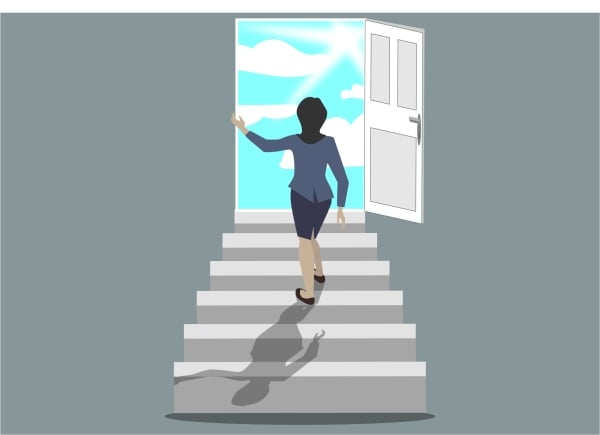Jobs
Lessons from a faculty member who left two tenure-track jobs (opinion)

It was unintentional, but it still hurt.
We were in the car heading to a movie. Since we’d moved to a new city in a new state, our 13-year-old often refused to be seen in public with her cringey parents. But today, she got into the car without a struggle, and she was talking to us. Energetically. About school!
Then, just as I’d been lulled into a happy place by the rhythm of the road and the joy in her voice, my daughter said, “Mom, I know you’re not an English professor anymore, but —”
Everything after that first part got hazy. I felt a sharp alarm of shame, as though she’d just pointed out I’d become a circus clown. In reality, I was no longer a tenured professor, which had been the cornerstone of my identity for as long as I could remember. Who was I supposed to be now?
Stumbling to defend myself, I told her I still feel like a professor, that I still use many of the same skills. She’d stopped listening, of course. But I was left to wonder whether others who’d left academia or long-term careers of any kind felt this desperate need to explain themselves.
So why did I?
The answer, I’m certain, is rooted in my own skewed story of success. I learned to love the life of the mind, the flexibility of being a professor and getting to see my students learn and grow more confident over time. However, I found myself torn between this love and the deep well of insecurity fueled by the scarcity mindset of higher education, which made me ask myself, was this actually my calling, or did I need to get out?
At the time, my response was to double down. Literally. I earned tenure, left that university and earned it all over again at another one.
Then, one day, I looked up and realized I’d found all the unicorns I’d been chasing, personally and professionally. Yet I was still looking over the horizon for what came next. Tal Ben-Shahar, the Harvard-trained psychologist, defines this feeling as the arrival fallacy, “the illusion that once we make it, once we attain our goal or reach our destination, we will reach lasting happiness.”
That longing for more, the nagging feeling that I had not yet found the thing I would do until I retired, motivated me to give up tenure — the first time — four days after I received it. Although I’d have to start over in a new tenure-track position, this university was larger and offered more money, autonomy and room to grow. Of course, this would finally provide the inner validation that tenured job No. 1 did not. Right?
Instead, my second crack at tenure forced me to ask myself whether I wanted to remain a faculty member for the long haul. My moment of reckoning came shortly after tenure No. 2, when I had to decide if I was willing to compromise my core beliefs to stay in what seemed to me to be an increasingly challenging environment stoked by a constant battle for resources. Hard work was no guarantee of anything. To survive, I needed to create a rich life outside my job. I also needed to find a new career.
So I became a student. Again. This time in the new-to-me field of human-centered design. It happened by chance during a fellowship at Stanford University. My very first class was designing an escape room as an alternative exam for a 10th-grade English class. I stood in the corner like an awkward seventh grader. Everyone around me seemed to know tons about puzzles, locks and games. What did I have to contribute?
Then I noticed a lone typewriter in the pile of Goodwill items we were using to create the escape room. I envisioned a note from Dr. Frankenstein in the typewriter with instructions for how to escape and reunite with the Creature. Our team got to work building something before we felt ready, then watched in amazement as students made their way through and out of Frankenstein’s laboratory to freedom. They were elated, of course, to be moving around our labyrinth rather than sitting to take a test.
When I returned to my own classroom, I showed my students how the tools and mindsets I’d practiced — like radical collaboration, embracing uncertainty and a bias toward action— could help them tackle their own problems directly within a supportive community. I also started teaching these skills and mindsets to others. For four years, I continued human-centered design work in conjunction with my faculty position and as a side hustle outside academia.
Before that double duty burned me out, I accepted a position at the Life Design Lab at Johns Hopkins University applying design-thinking tools to help students navigate their personal and professional lives. This meant facing their own insecurities and crafting their stories in collaborative and meaningful ways.
Starting something new and different wasn’t easy, especially later in life. Some days, I felt I’d been demoted, that I was invisible in a young field filled with younger faces than mine. It took me over a year to feel confident enough in this role to begin seeing myself as capable of more.
That said, I can’t really tell students and working professionals about the importance of adaptability unless I am willing to make a big enough leap to truly understand the fear that goes along with these kinds of risks. The leap out of the tenure track and into human-centered design encouraged me to apply for an opportunity at Hopkins’s Bloomberg Center for Public Innovation. They were looking for someone with combined skills in human-centered design, civic engagement, coaching and storytelling. That was also me, wasn’t it?
And, yes, I’m now realizing, it was and is. There are days, of course, when I feel entirely lost in a sea of new processes and acronyms. But I’m still learning to reframe limiting beliefs about myself. My skills as an empathetic communicator allow me to create connections between groups of strangers, giving them ownership over what their communities might become.
That is what life design is about: taking agency over your own life—especially the hazy and uncomfortable parts. While I will always miss my students and getting to talk and write about books as part of my job, I now get to use these skills to help innovation teams craft stories about the largest challenges their cities face and how best to address those challenges.
Recently, I attended my final class for an organizational leadership certificate at Carey Business School. We were asked to volunteer to sit in the hot seat and share an idea we had developed with a somewhat resistant audience. Before I could overthink it, I volunteered. I pictured my skeptical daughter and my own students in the audience. They needed to understand the relevance of the idea in a simple and clear way. They needed to believe I was fully hearing their questions and concerns. This isn’t so different from what I did as a professor and what I do now as a senior adviser for innovation teams: listening to understand, ensuring others feel heard and valued, and challenging them to go beyond their initial assumptions to fully consider perspectives that differ from their own.
I’ll always feel a little defensive when I hear someone joke about lazy or entitled professors. And I’ll likely always miss being called Dr. Braun. But my perspective from the other side of this pivot has made me less likely to judge anyone by their professional label or pedigree. I’m more curious to learn their strengths and skills and the type of impact they want to have in the world.
So what is the key lesson of my story for others, especially those in faculty positions? Regardless of our very real fears and challenges, we all have pockets of agency, small actions we can take that will lead, over time, to bigger and more lasting changes. If I could go back to tell my terrified, pre-pivot self anything, I’d tell her that taking a leap into the unknown doesn’t mean leaving behind who you are or where you’ve been. It doesn’t actually mean starting over. It means expanding your perception of yourself and what is possible. It means having just enough faith to believe you already have what you need to begin.










